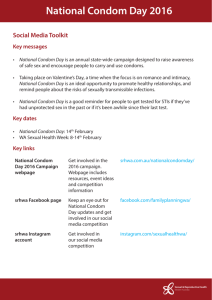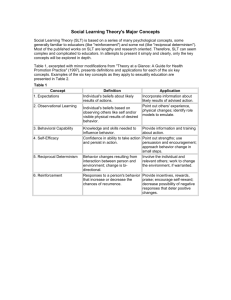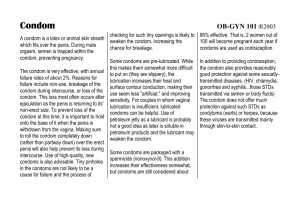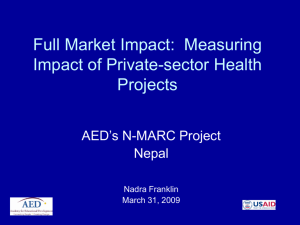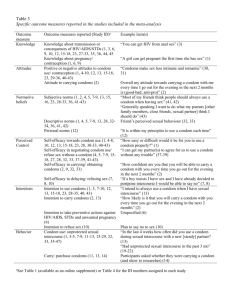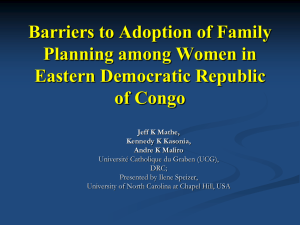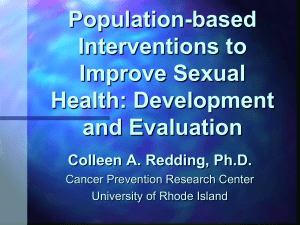Health Promotion and Behavioral Change
advertisement
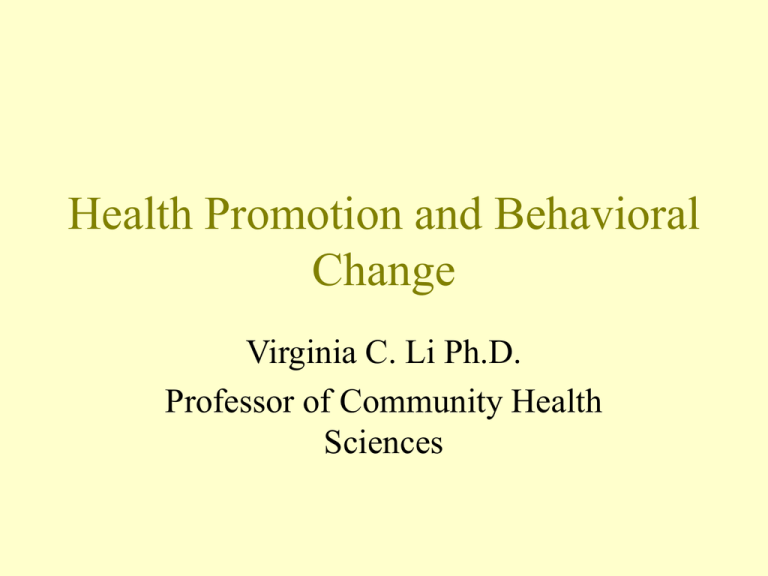
Health Promotion and Behavioral Change Virginia C. Li Ph.D. Professor of Community Health Sciences Health Promotion (Green) The combination of educational and environmental supports for actions and conditions conducive to health An Ecological View on Health Promotion • • • • • -Intrapsychological factors -Interpersonal processes -Institutional factors -community factors -public policy Health Promotion in Community Health promotion actions means: • -create supportive environment • -strengthen community action • -develop personal skills • -reorient health services • -build healthy public policy Health Education Any combination of learning experiences designed to facilitate voluntary actions conducive to health Principles of Health Education • • • • • • • • • -principle of educational diagnosis -hierarchical principle -principle of cumulative learning -principle of participation -principle of situation specificity -principle of multiple methods -principle of individualization -Feedback principle -principle of intermediate target HEALTH BEHAVIOR • Any action taken to prevent illness or to detect it at an asymptomatic stage. • Wellness Behavior: Enhances health/stay well • Preventive Behavior: Prevents/detects illness • At-Risk Behavior: Creates risk for illness • Health-related Collective solutions Social Action: for risk reduction DIMENSIONS OF PREVENTIVE HEALTH BEHAVIOR (LANGLIE) Indirect Risk PHB PHB • Medical checkups • Dental care • Immunization • Screening behavior Direct Risk -Pedestrian behavior -Driving behavior -Hygiene behavior -Smoking ILLNESS BEHAVIOR • · Any action taken in the presence of symptoms, to define the state of health and to discover suitable treatment. • · Consultation with lay persons • · Help-seeking behavior Environmental influences on Health and Illness Behavior • • • • • • • Competition/regulations Resource dependence Medical technology Population Changes Sources of payment Cost of medical care Ethics in human services • Behavioral Indicators: Dimensions: • · Compliance • · Consumption patterns • · Coping Promptness • · Preventive actions • · Self-care • · Utilization -Frequency -Persistence - -Quality -Range Principles of Health Education Applied to Sexual Behavior in AIDS Control and Prevention Behavior Dimension Example Time and promptness of the behavior Use condom when sexual intercourse with multiple partners Frequency of behavior Quality of behavior Use condom every time having Range of health behavior Having monogamous relationship, Use condom, Avoid having multiple partners, Abstinence Check condom to make certain no leakage, Use condom correctly GENERAL PRINCIPLES IN CREATING HEALTH BEHAVIOR • 1. Information dissemination awareness for • (Media/teaching) behavior change • 2. Community/Institutional/ Change norms for • Organization (Training) behavior change • 3. Environmental or policy Change opportunity • access change ===> Change ===> ===> HEALTH PROMOTION • What strategies are appropriate theoretically and practically to: • a. discourage risky behaviors in populations at risk? • b. encourage heathy behaviors in populations at risk? • c. assure healthy social and physical environments? • d. evaluate that we have had an impact? THE ANTI-SMOKING CAMPAIGN • • • • • • • • • • • • • • Clear-cut epidemiological evidence (Risk perceptions) 2. Creation of awareness (Media campaign--Health beliefs) 3. Change behavioral norms (Intensive education of at-risk groups: Soc. Learning Theory, Locus of Control) 4. Help people change (Smoking cessation/support groups: Learning, BH Modification) 5. Create a villain (Tobacco industry: Media advocacy, Causal attribution) 6. Change access to product (Taxes, disincentives: Structural) 7. Change the rules (Disincentives: anti-smoking policies) The Case of Tobacco Control • • • • • • • • • • • • • • • • • • • • Proposition 99- building alliance for tobacco control Types of Smoking Control Programs -Worksite Control Programs -Worksite Control Policies -School Based Control Programs -Community Based Control Programs -Physician/Clinic Based Control Programs -Policy-Based Smoking Programs -Economic-Based Smoking Programs Policy and Environmental Interventions -clean indoor air -restricting tobacco advertising and promotion -restricting use access to tobacco -comprehensive school health programs -price/excise taxes Additional interventions -insurance premium differentials -reimbursement for smoking cessation -differential hiring of smokers -litigation as policy Issues on Compliance Compliance • Overview of Problem: KAP,Social Influence, Coercion • Measurement Doctor-Patient Interaction • Cognitive & information processing (Philips) • • Study of surgical patients (Egbert) Training patients to ask question of their doctors (Rotor) ELEMENTS OF THE HEALTH BELIEF MODEL • • • • • • • • • Perceived Threat Perceived seriousness of illness Perceived susceptibility of illness Outcome Expectations Barriers to health behavior Costs/benefits of health behavior Efficacy Expectations Ability to carry out the action Cues to Action Health Belief Model Constraints • Validity of belief-behavior relationship • Hard to modify beliefs • Need to look at interpersonal AND environmental • Works less well for chronic or habitual behaviors (learning curves, strategies) • Lack of quantification • Potential for blaming the victim Social Learning Theory (Bandura) • • • • • • • • • • MODEL OF SELF-EFFICACY • Cognitions---------->Behaviors---------->Outcomes • Self-Efficacy Outcome Expectations Outcome Expectations --The expectation that certain actions will lead to a desired outcome. Efficacy Expectations --The expectation that the individual can perform the behavior or complete the task. Self Efficacy information derives from four sources: -Performance attainments (personal mastery of experience) -Vicarious experience (observation of successful or unsuccessful experience of others) -Verbal persuasion (exhortations) -Physiological state (particularly anxiety or success in eliminating negative affects) Major Concepts in Social Learning Theory and Examples of the Application in STD Clinics of Control of AIDS • • • • • • • • • • • • • • • • • • • Examples Environment and Situation Clinician involvement in the program’s activities; Training clinicians in health education and Counseling for AIDS testing Behavior capabilities Managing emotional arousal Able to demonstration condom use Expectancies Doctor-patient communication during routine care Self control Goal setting exercises to increase voluntary AIDS testing and condom use Observational learning Pictorial role models in AIDS testing acceptance in feeling good using condom, and in monogamous relationship Using condom correctly Reinforcement Provide free condom Reciprocal determinism * Targeting a high risk population in a doctor-patient context through personal skill development and a supportive environment * Continuing interaction between a person, the behavior of that person, and the environment within which the behavior is performed ISSUES IN LOOKING AT HEALTH BEHAVIOR THEORIES Context: --Effects beyond the individual’s control --Measurement of these? Attitude/Belief/Behavior • --Correlations? • --Causal relationships? • Measurement of this awareness: • --Accuracy in reporting • --Attitudes • --Values • --Intentions • --Behaviors • · Need for Observation

